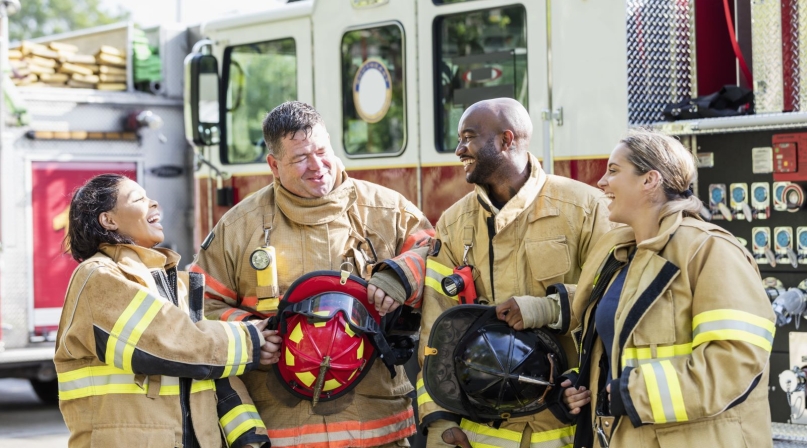Counties reach out to diverse recruits to shore up firefighting teams

Key Takeaways
The effects of firefighter shortages are being felt nationwide, as counties struggle to staff their fire services amid increased need and rising call volumes.
Counties across the country, including Wake County, N.C., Kershaw County, S.C. and Mariposa County, Calif., are getting more intentional about the shortage by diversifying their fire services, creating programs to recruit younger people and more women and people of color.
According to the Bureau of Labor Statistics, roughly 95% of career firefighters in the U.S. are men and about 85% are white — those numbers are even higher in Wake County, at 97% and 94%, respectively. The county leveraged $2.3 million in American Rescue Plan Act to address both its firefighter shortage and its diversity gap, partnering with Wake Technical Community College and six county fire departments to recruit a wider demographic to their fire services department.
The funding allowed the county to, for the first time, pay people going through the 38-week EMT (emergency medical technician) and firefighter academy training, with the exception of the city of Raleigh and town of Cary, which have separate fire services and previously provided pay throughout the training process.
“We looked at what some of the challenges that our fire services folks were facing, and we looked at the demographics and we recognized that there’s a large population of people who haven’t been recruited for positions like this, they may not even be aware,” said Wake County Manager David Ellis.
“We had one huge barrier in place … that’s 38 weeks that we were asking folks to not receive a check or any benefits, so we changed that and just got out and knocked on doors of our partners out in the community and just really put the word out about the program and how we really wanted to engage a population that hadn’t previously been engaged in fire services.”
Darrell Alford, Wake County’s Fire Services and Emergency Management director, said the county recognized it needed to update its recruitment strategy, which had traditionally been letting people know of openings through word of mouth and postings on the fire services’ website. To engage a wider audience, the county created a grassroots campaign, working with non-profits and faith-based organizations, putting on expositions at community centers and advertising on the radio to get the word out about open positions in fire services.
“In order for somebody in the past to go through the [fire services] academy, you had to be still living with mom and dad or your spouse had to be supporting you, something to where you didn’t need to get paid for 38 weeks, so that was one of the first barriers,” Alford said. “The next thing was changing the way that the fire departments were recruiting … We met with some [people of color] who were already in the fire service in Wake County, and we asked them, ‘What drew you to this profession and what can we change to make it better?’
“We also had some workshops for the fire chiefs where we kind of changed cultures, you know, maybe not asking a fireman to live within the fire district. [Previously] that was some of the rules – if you were going to serve on X fire department, then you had to live within so many miles of X fire station, so changing that culture, recruiting more women and making the departments look more like their communities.”
Following the recruitment push, Wake County Fire Services received more than 1,000 applications for 36 positions. For the next fire services academy training, which starts this week, the county has received more than 900 applications for 18 positions, according to Alford.
There were 200,000-plus more volunteer firefighters across the country in 1984 than there were in 2020, while emergency call volumes tripled in that timeframe, leaving volunteer firefighters overworked and burned out.
The pandemic exacerbated that issue further, making it even more difficult for rural counties like Kershaw County, S.C. that function primarily through volunteer firefighters.
“A lot of times, people don’t really know the fire services are volunteer in their area, a lot of people just have that perception of, they call 911, somebody is going to show up,” said Will Glover, Kershaw County fire chief. “… COVID put a huge damper on us as far as recruiting and maintaining [staff]. During that time, the fire service took a hit on volunteers, and since then, we’ve been struggling to try to catch up.”
As a response, Kershaw County Fire Service has hired a recruitment and retention officer and been more intentional in getting the word out about needing volunteers through a TV recruitment campaign and billboards.
“We’re not the only fire service that’s struggling to bring in new volunteers — across the nation, it’s become an issue and I think there are so many different things that play into it,” Glover said. “I think that being a volunteer now, there’s more training requirements than there used to be 30 to 40 years ago, so there’s a lot of time requirement and … I feel like the work-life balance, people value that ‘life’ side more than the ‘work’ side now, and it’s hard to commit so much time to volunteer.”
Kershaw County also partners with the school district on a junior firefighter program for high schoolers to get a younger crowd involved in fire services, which has an increasingly aging workforce, particularly in rural areas.
According to a 2020 study by the National Fire Protection Association, more than a third of volunteer firefighters in rural areas are 50 or older.
Mariposa County, Calif. has a similar program in partnership with Mariposa County High School, Grizzley Fire, which provides training to students as young as freshmen in high school who are interested in becoming firefighters or emergency medical responders.
Due to increased demand, Mariposa County also created ‘Extra-Help’ part-time paid positions last year to help out California Department of Forestry and Fire Protection (Cal-Fire) firefighters and volunteers.
“Fire Services responds to way more than just fires,” Glover said. “We respond to medical calls, hazmat calls, wrecks, so call volume has gone up and to supplement that a little bit you’ve seen fire departments hire on paid staffing, which, 15 years ago, if you had three paid departments in an area, then they got all of the applications, well now those three departments have to compete with seven more departments that have now put full time staff in order to try to supplement the volunteer side a little bit, so there’s more competition.”
Mariposa County has also opened up “medical emergency response only” volunteering as an option, according to Mariposa County Supervisor Rosemarie Smallcombe. These volunteers would be able to perform CPR or set someone’s arm in the case of an emergency, but wouldn’t be the ones to respond to the fire itself.
“At least two-thirds of the calls for our fire department are medical, so we added a ‘medical-only’ responder in order to augment the resources that we have available to respond to those kinds of calls,” Smallcombe said. “And that’s particularly important because Mariposa County, like a lot of rural areas, has a fair number of older folks. The California Department of Aging says that 40% of our population is 60+, so that emergency medical response is a big part of that.”
“And that’s particularly important because Mariposa County, like a lot of rural areas, has a fair number of older folks. The California Department of Aging says that 40% of our population is 60-plus, so that emergency medical response is a big part of that.”
Former Fire Chief Richard C. Kline of Plymouth, Minn., writing in Fire Engineering, said volunteer firefighter programs are using incentives to attract new volunteers.
That might come in the form of both tangible and non-tangible “rewards,” such as employee recognition programs, childcare, gift vouchers, tuition reimbursement, cash bonuses and professional development opportunities. Health and fitness programming is one more enticement.
A survey shows fire department-sponsored fitness programs would help recruit new volunteers and promote teamwork.
NACo's New Career Center
Connecting Talent with Opportunity
Good employees are crucial to getting the job done. Through our new career center, NACo provides a method for counties to find the right people to fill staffing vacancies.

Related News

Congress introduces Second Chance Act reauthorization
On April 16, the Second Chance Reauthorization Act of 2024 was introduced in the U.S. House of Representatives with robust bipartisan support. NACo supports this legislation, which would reauthorize funding for Second Chance Act programs for five years.

DOJ issues final rule for state and local governments to implement web-based accessibility standards
On April 8, the U.S. Department of Justice (DOJ) announced the release of a web accessibility final rule for state and local governments.

HRSA offers funds to aid care transitions for justice-involved individuals
On April 10, the U.S. Department of Health and Human Services’ Health Resources and Services Administration (HRSA) announced the availability of $51 million in funding opportunities open to HRSA-funded health centers.
